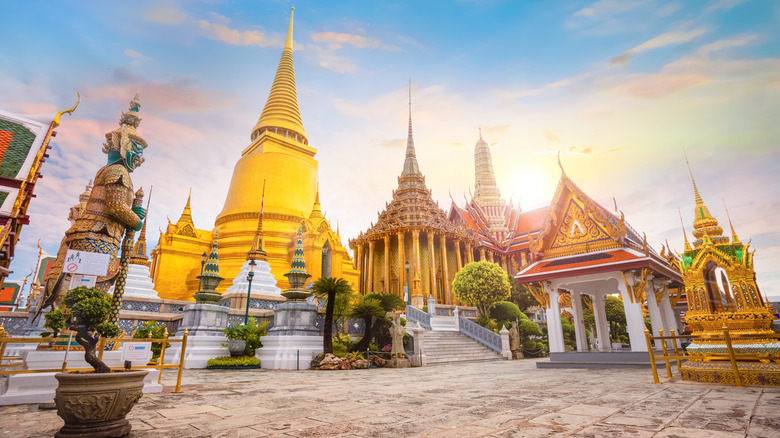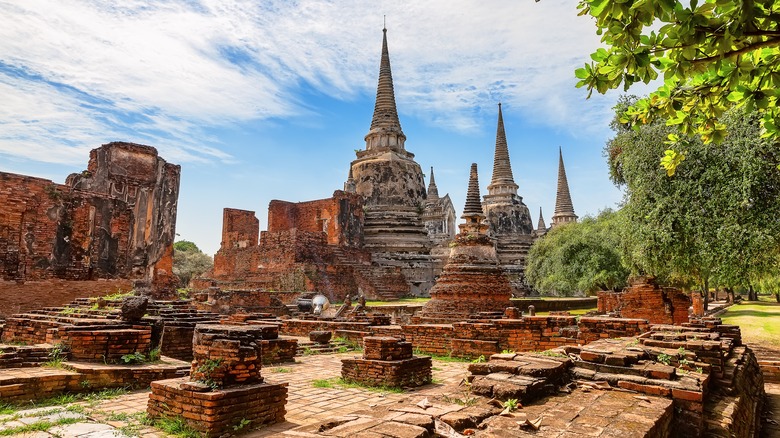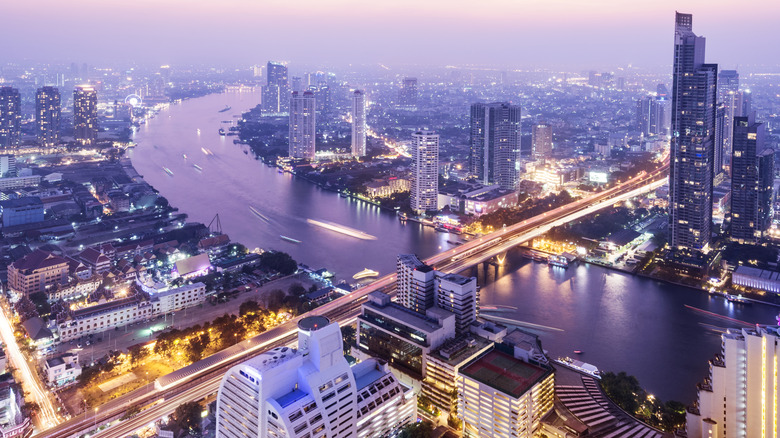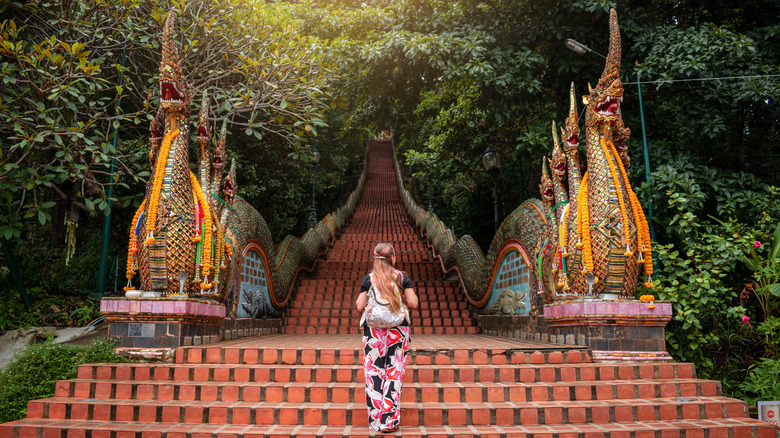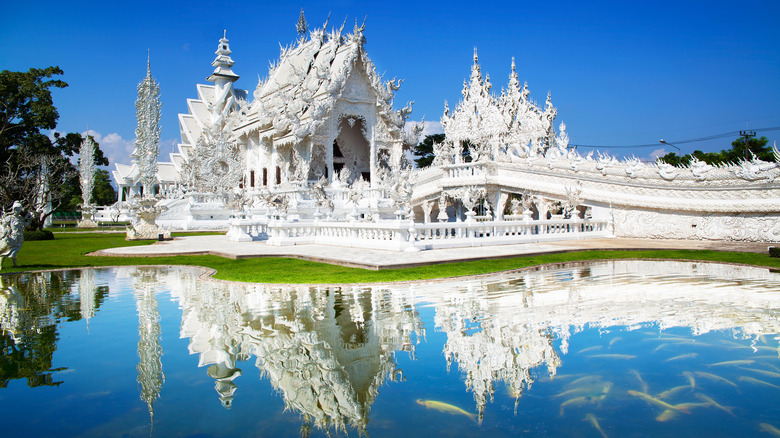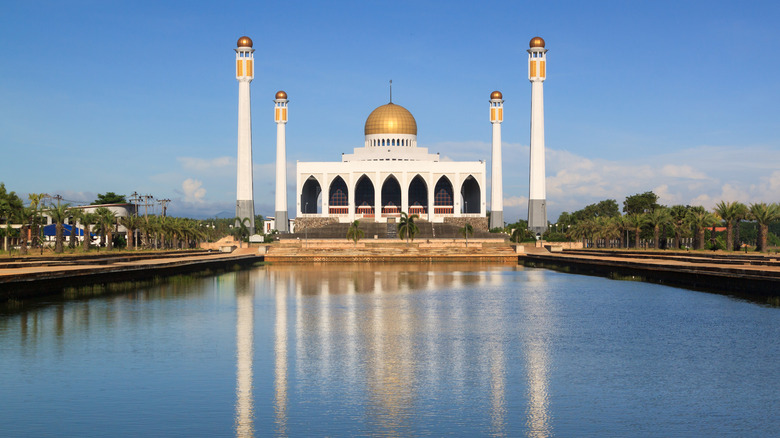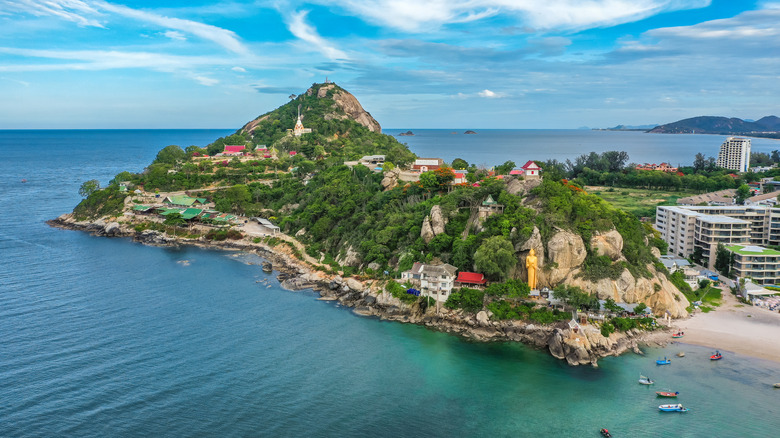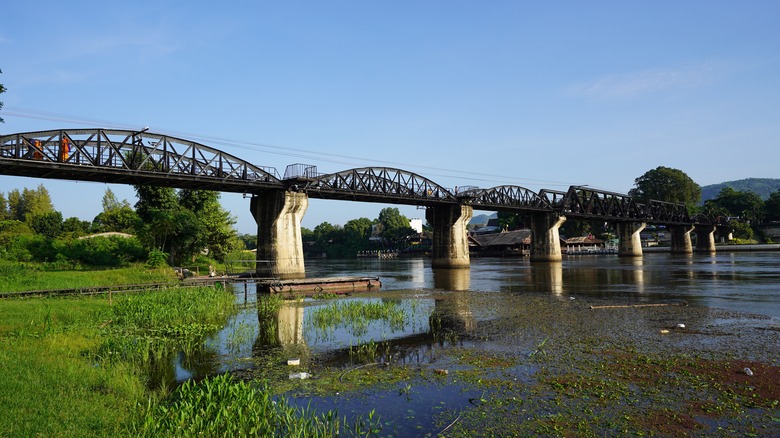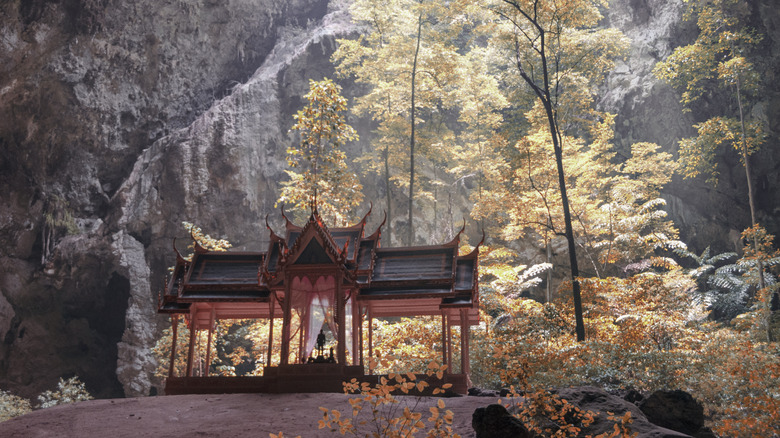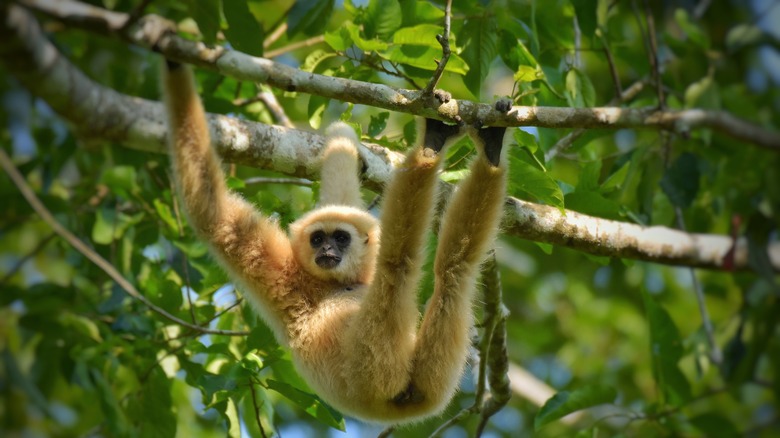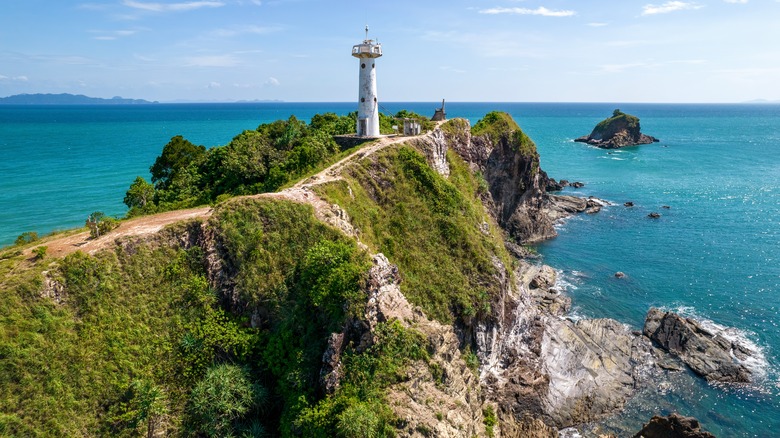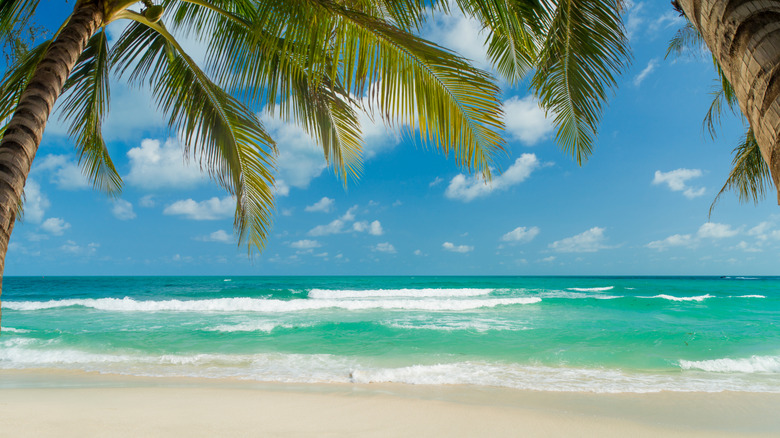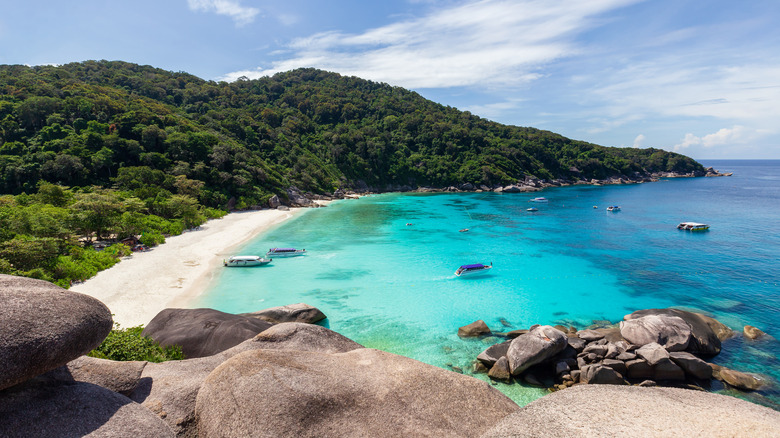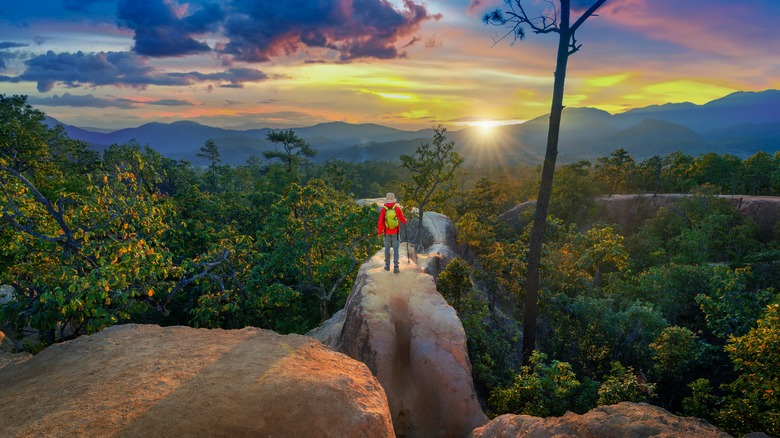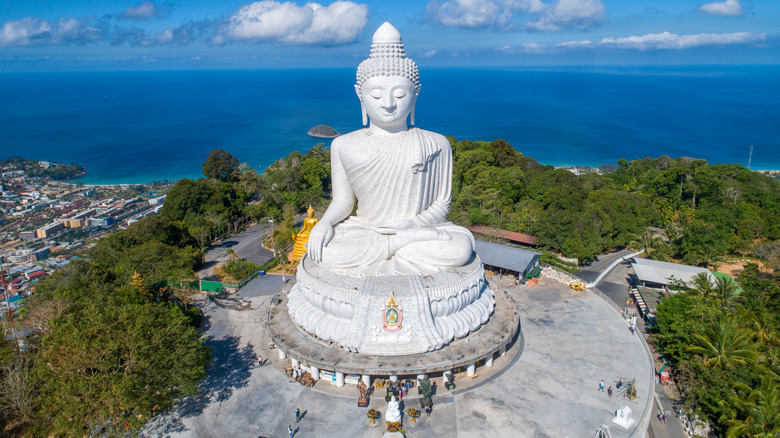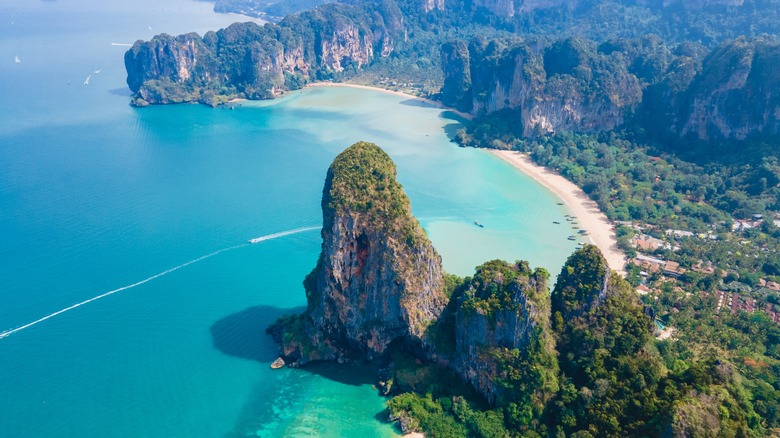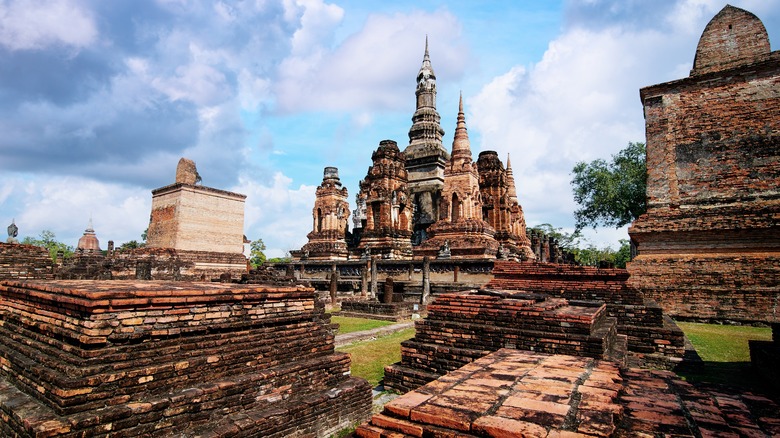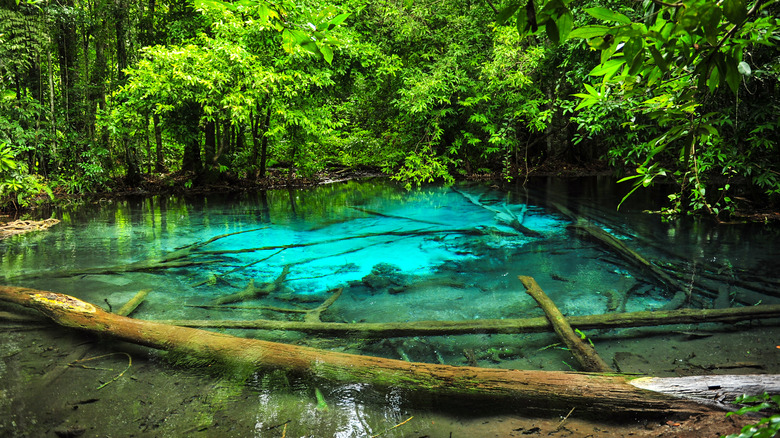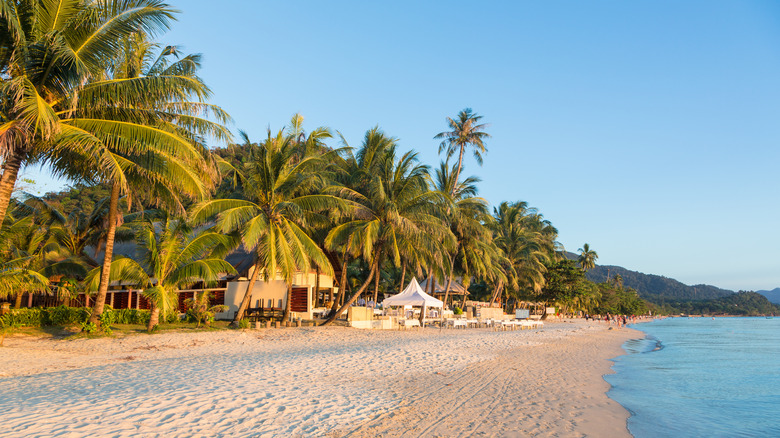18 Best Places To Visit In Thailand
One of the most exciting destinations in Asia, Thailand is beautifully set up for vacationers. With a tourism industry that is well developed, reliable transport options, mouthwatering (and fiery) food, a huge variety of scenery, and some of the most incredible temples in the world, the Southeast Asian nation is justifiably a place that many travelers to Asia yearn to see. It's a country where tourists could easily spend months hopping from sublime beaches to forested peaks, from frantic cities to tranquil countryside. It's also relatively inexpensive, with life in Thailand markedly more affordable than in the United States.
Getting around the country is easy, with a far-reaching rail system, a good network of flights between destinations, and buses and boats connecting many spots. Given the vast range of places to see and the affordability of Thailand, visitors might find themselves more likely to run out of time before money, so savvy travelers will think about winnowing down their choices, focusing on specific sites worth seeking out. If you need to know where to go, the list below will certainly help — we've put this together based on personal knowledge gleaned when visiting the country while also focusing on the importance of having a good geographical spread and also to enable you, the reader, to have a range of experiences across different environments.
Ayutthaya
This UNESCO World Heritage site, known officially as Phra Nakhon Si Ayutthaya, lies a short distance north of Bangkok. A visit here will bring travelers close to the incredible ruins of what was once, many centuries ago, the capital of the Kingdom of Siam. Ayutthaya was founded in the mid-1300s and was a thriving center for four centuries before being destroyed in 1767 by the Burmese army.
The site was chosen for many reasons. It was close to three rivers, allowing for marine trade but far enough from the sea and its tides to ensure foreign battleships couldn't reach here. Today, the park is a shadow of the former city in terms of size and scope, but walking around the towers and monastic buildings gives visitors a sense of the grandeur of the metropolis. Regional influences are apparent in the shapes of certain structures, especially some towers that recall the forms found at Cambodia's Angkor Wat.
Bangkok
The joy of the current Thai capital is that, day or night, there is always something to do. Bangkok, known by Thais as Krung Thep Maha Nakhon (loosely meaning Big City of Angels), is a churning circus of delight, with sizzling street food, stunning temples, and shopping everywhere. The public transport system is extensive and inexpensive, with a great subway called the BTS Skytrain (which is technically overground) and cheap taxis. Bangkok is where to find arguably the most famous backpacker street in the world, Khao San Road, where banana-Nutella pancakes and cheap beer keep travelers happy.
For more authentic city sights, temples like Wat Arun Ratchawararam, Wat Pho, and Wat Benchamabophit ("wat" is Thai for temple) will have visitors gazing in awe at the gilded spires and steep rooflines. Elsewhere, the street food in the Chinatown area called Yaowarat will have diners licking their lips, and shopaholics can splash the cash (or plastic) at the multi-story malls and sprawling night markets.
Chiang Mai
Temples are among the highlights of a trip to this laid-back city in the north. The 14th-century Wat Phra Sing is among the most revered shrines in Chiang Mai, its large Buddha idol sitting in a gorgeous hall decorated with ornate wood carvings and intricate murals. The statue is the focal point during the annual Songkran festival (marking Thai New Year) held every April and is paraded around town as part of the celebration. On the outskirts of town, Wat Phra That Doi Suthep has a long staircase leading to the main pagoda temple and statues of serpents visible on the sides. The views of Chiang Mai and the beautiful countryside surrounding it are breathtaking.
Visitors looking to stock up on gifts can find endless choices at Sunday's Thapae Walking Street, a vast evening market where crafts, clothing, and more wait to be snapped up. Be sure to try the food in Chiang Mai, where Lanna cuisine (named for the culture in this part of Thailand) is less sweet than the dishes further south, using more herbs and not as reliant on coconut milk.
Chiang Rai
A three-hour drive northeast of Chiang Mai, Chiang Rai is another serene city packed with heritage. It also shares its name with the province near Thailand's borders with Myanmar and Laos. There are many mountains here, making for some beautiful natural scenery. One of the most spellbinding sights is Wat Rong Khun, a temple that is a brilliant white color, a color intended to represent the purity of Buddha. Located around 8 miles from Chiang Rai, the temple buildings and statues sparkle in the sunlight. Glass is embedded in the white plaster, making the whole place seem ethereal and otherworldly.
Another nearby temple with an extraordinary hue is Wat Rong Suea Ten. This time, the color is a deep, rich blue, seen on statues, roofs, and buildings. Chiang Rai has fantastic trails for countryside hiking and options for arranging trips to visit people living in the mountain communities around the city.
Hat Yai
Close to the Malaysian border, Hat Yai has excellent markets and a fascinating mix of cultural influences. The large university here ensures that there is a strong educational presence in the city, and Hat Yai is also a hub for transportation in the south. Shoppers will enjoy the wares at busy markets like Kim Yong Market and Santisuk Market, with the latter especially popular for electronics.
While other parts of Thailand are notable for their striking Buddhist temples, Hat Yai's most appealing religious structure is the Songkhla Central Mosque, a few miles north of the city. It has a grand gold dome in the center and four soaring minarets around its perimeter, while a reflecting pool in the front helps to frame the structure (the reflections of the mosque in the water are riveting). Hat Yai also has Buddhist temples, with the more than 100-foot-long reclining Buddha statue at Wat Hat Yai Nai being particularly impressive. For amazing city views, take a cable car ride to the hills above Hat Yai. Be aware that the cable car doesn't run in bad weather.
Hua Hin
The part of Thailand where, historically, the Thai royal family would spend summers is located less than three hours southwest of Bangkok by car. Visitors will find much to enjoy here beyond the beaches, which are predictably pretty, with the calm water of the Gulf of Thailand providing excellent swimming. A little north of the city, Maruekhathaiyawan Palace was constructed in the 1920s, repurposing teak from another palace to create its breezy, bright form. Visitors can pay a small entrance fee to tour the building, known as the "Palace of Love and Hope."
As in many Thai cities, shopping isn't just restricted to the daytime. The Hua Hin night market offers clothing, crafts, jewelry, and many places to eat, with seafood especially popular. For some unique outdoor exploration, Wat Khao Takiap sits on a hill just south of Hua Hin and has fabulous city views and the remarkable sight of a giant Buddha statue by the waterfront, set among a jumble of imposing rocks.
Kanchanaburi
Moviegoers of a particular generation will likely remember the epic film "The Bridge on the River Kwai," a tale set during World War II where prisoners of war were enlisted to build a bridge by their Japanese captors. While the film was a work of fiction, it was loosely based on a true story. The actual bridge is very real, located in Kanchanaburi province, not far from Bangkok. It has become quite the tourist spectacle, even spawning an annual River Kwai Bridge Festival that honors those who perished here in the war and features performances, cultural shows, and fireworks.
Many soldiers from that era are buried in the Kanchanaburi War Cemetery, while the Jeath War Museum looks at the harsh conditions that prisoners had to endure. The countryside here is a welcome relief from the urban landscape, and visitors will see forests and rivers, experience cooler air than in nearby Bangkok, and have the chance to raft and hike.
Khao Sam Roi Yot National Park
Getting to this park from Hua Hin is simple as it is less than 40 miles from the seaside city. For a sense of what to expect here, visitors only need to look at the park's name, which loosely translates to "The Mountain with 300 Peaks." The incredible, moody limestone karsts that are the hallmark of certain parts of coastal Thailand are on show here, as well as small bays and stretches of empty beach. There are also sections of mangroves, marshy areas, and canals.
The main spot that attracts most visitors is Phraya Nakhon Cave, a mammoth chamber where light manages to stream in, a cave that has its own environment, with plants growing within. There is even a structure inside the cave built to celebrate a former king who visited the park many years ago. Elsewhere in the park, travelers can find more caves to explore and a massive area of wetlands.
Khao Yai National Park
For visitors to Bangkok wanting to immerse themselves in nature, Khao Yai National Park is a tremendous option, situated around 90 miles to the northeast. Khao Yai is part of a UNESCO World Heritage site together with the Ta Phraya National Park to its east and is prized for its rich plant life and extensive selection of mammals, birds, and reptiles. This is an important habit for wildlife, including many endangered species.
While travelers might not see the Siamese crocodile, the most endangered of all the animals here, they can visit knowing that it still lives in the park, as do the leopard cat and the banteng, a type of cattle indigenous to here. Khao Yai is also the only place on Earth where the white-handed and pileated gibbons share habitats and cross-breed. Numerous environments appear throughout the park, from tropical rainforests to sweeping grasslands and dry evergreen forests, another reason for the great diversity of flora and fauna in Khao Yai National Park.
Ko Lanta
An easygoing island (Ko, also spelled Koh, is the Thai word for "island"), this destination in Krabi province has fantastic beaches. Some see it as a more relaxed, less commercial alternative to Phuket, the larger island to its northwest. The languid pace of development here, for some, makes this a refreshing vacation spot, and its different beaches appeal to different types of travelers. Klong Dao, for instance, is set near the arrival point for most boats and has a good range of places to stay, making it a popular choice among families that visit.
Ko Lanta attracts many backpackers who come for some simple relaxation, and it's also a big draw for divers, primarily for the clear water and vibrant reefs. The small islands south of Ko Lanta, past the lighthouse, are also excellent spots for snorkeling and diving. Access to the island, which has a mountainous spine that gives it a real sense of drama, requires getting on a long-tail boat or ferry.
Ko Samui
This island is possibly the most deluxe in the country. Visitors are lured here by the fabulous beaches, especially during the drier months of December through August, with the first few months of each year especially busy. Much of the activity of Ko Samui centers around Chaweng Beach, a sweeping stretch of sand that extends for miles along the sea. This is the beating heart of the island, a neighborhood with beach clubs, plush resorts, restaurants, cafes, bars, shopping, and bustling nightclubs. There is even a water park, excellent watersports adventures, and mini-golf courses in this part of the island.
A much quieter option is Lamai Beach, another gorgeous area of sun, sea, and sand. At the southern end of the beach, travelers will find the large, weathered boulders known as Hin Ta Hin Yai (this translates to "Grandfather and Grandmother Rocks"), mammoth granite formations that have been colored and eroded by the forces of wind and seawater.
Ko Similan
Keen divers will be all too aware of the charms of Thailand's waters, especially this idyllic chain of islands. Derived from the Yawi word for "nine," Similan refers to a group of islands established as a national park in 1982. While Ko Similan is just one of the islands in the archipelago, it is often used to help identify the greater sum and is part of the official marine park name — Mu Ko Similan National Park.
This is one of the best diving locations in the world, with rare types of coral and a vast array of marine creatures to see. Divers can look for sponges, whale sharks, dolphins, turtles, eels, lobsters, and more. Limits are placed on the number of visitors, with only 525 divers allowed daily, though many more can swim, snorkel, and admire the water. There is very limited lodging on the islands, with only bungalows and campsites available, so visitors usually stay at Khao Lak on the mainland.
Pai
Not far from Chiang Mai, this town is an excellent place to experience pastoral Thailand. Pai is well accustomed to overseas visitors and has a developed tourism scene. Travelers come here to explore the countryside, to go rafting in the river, and for the ability to really get close to nature by camping in the region.
In terms of traditional sights and constructed landmarks, Wat Phra That Mae Yen is usually near the top of the list. Set up on a hill in a small village on the outskirts of Pai, this temple has fantastic city views, not least from the giant white Buddha that anchors the shrine. For another serene excursion, join the scores of travelers who head to the area's rivers to go tubing, a soothing, low-impact way to enjoy the splendid scenery. Fans of pachyderms can book a stay at Thom's Pai Elephant Camp, where they can even learn what it takes to be a mahout, the official name for an elephant handler.
Phuket
This is one of the most popular islands in Southeast Asia, with a coastline that curls and weaves, creating headlands, promontories, deep coves, tucked-away inlets, and a good selection of gorgeous beaches. At times, the size of the place might make visitors forget that Phuket is an island, the largest island in the country, no less.
Size is also a talking point at Phra Phuttha Ming Mongkhon Ek Nakkhiri, known by many simply as Phuket Big Buddha, a complex with a mammoth statue of Buddhism's founder. The idol of Buddha is more than 150 feet in height and is built of concrete and marble. From its vantage point on Nakkerd Hill, the statue offers views of some of Phuket's most famous stretches of waterfront, like Karon Bay and Chalong Bay. There are many beaches around the island, from popular spots like Rawai and Mai Khao to hidden-gem refuges such as Banana Beach. Fans of sunsets should hit Laem Phromthep, in the island's south, for peerless views of the sun disappearing below the horizon.
Railay Beach
This peninsula in Krabi province can only be reached by boat, making it feel like an island, a trick of geography that might seem confusing until you get there. The broad, sandy beach on the west of the peninsula gently curls along the water across a narrow strip of land from the main ferry pier on the east, and since it faces west, the sunsets are spectacular. They are especially stunning at low tide when the sea recedes to leave small patches of water reflecting the sun as it drops, setting the ground ablaze in golds and pinks.
The scenery is also hypnotic, with towering limestone cliffs at either end of the beach. These cliffs attract many visitors who come to Railay Beach primarily to climb the rocks but also to take advantage of the sumptuous sand and sea. A small cave shrine called Phra Nang is the sole traditional tourist site, a little haven that sailors particularly revere.
Sukhothai
The center of life in the post-classical Sukhothai Kingdom, Sukhothai is another fascinating journey into the past. Along with other nearby towns, Sukhothai is a UNESCO World Heritage site, part of a nexus that was home to temples, monasteries, military outposts, and a governmental body, all of this existing more than 700 years ago. The grandness of the development will be evident during a visit to the Sukhothai Historical Park, where the temples, pagodas, large statues of Buddha, moats, and sturdy walls attest to the scope of this center.
There are even remnants of a dam used to control the water supply, illustrating the advanced engineering and planning in place many centuries ago. One highlight is Wat Si Chum, a temple where a huge Buddha seems to fill the entire space. The statue is brightly lit from above as the shrine's roof is no longer intact, destroyed by the ravages of time.
Thung Teao Forest National Park
Krabi is a province that tourists often visit just for the beaches, including several spots mentioned in this list. But Krabi isn't all about the sea. Thung Teao Forest National Park is a deep dive into the wonderful world of flora and fauna, with walkways that pierce canyons of trees and waterways that delight for various reasons.
The marquee attraction here is the emerald pool, also known as the crystal lagoon, a gorgeous body of water whose shimmering colors mesmerize all onlookers. It's also an excellent place for a refreshing dip and a beautiful spot for cooling off from the tropical temperatures. Other parts of the park offer stunning contrasts, from the whites of limestone cliffs to the dense green of thick jungles and forests and some seriously excellent birdwatching. While it doesn't really get cold here, be sure to spend some time in the natural hot springs that flow through sections of rock. There is never a bad time to experience natural hot springs, after all.
Trat
A low-key town southeast of Bangkok and close to the border with Cambodia, Trat has a seductive, easygoing charm about it, as it has yet to succumb to the lure of mass tourism. It also features some excellent shopping, a busy commercial center with plenty of trading in precious gems (there is a strong ruby mining industry in Trat province), and one that welcomes plenty of potential buyers and sellers from neighboring Cambodia. Some of that trade will be in fruits, as Trat is a powerhouse for growing produce, helped by consistent rainfall that keeps fruit trees healthy and hydrated. Among the sweet delights are longan, mangosteen, and salak, or snake fruit, named for its scaly skin.
For many, Trat is just a stopover for a trip to nearby islands. The largest is Ko Chang, a destination with undulating mountains and hills, sheer cliffs, and large tracts of forest. There are also some astonishing beaches, especially along the west coast.
